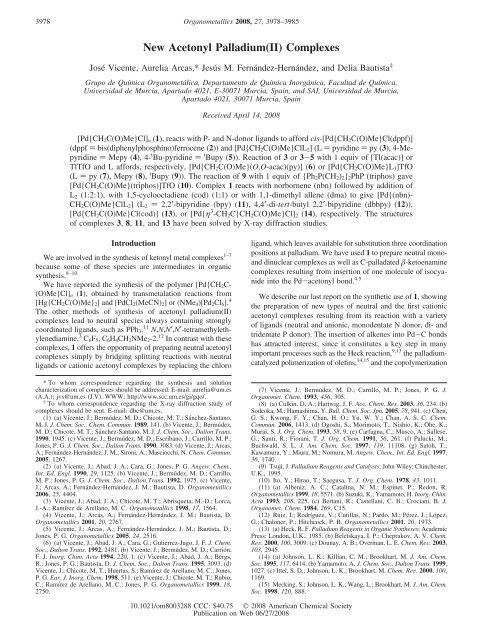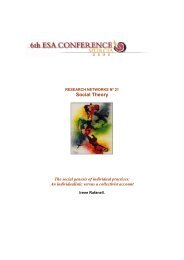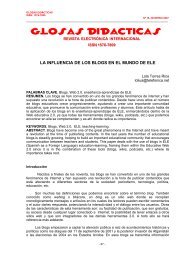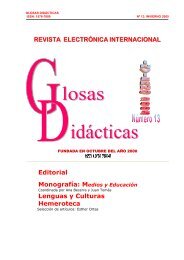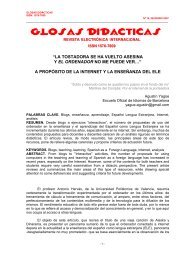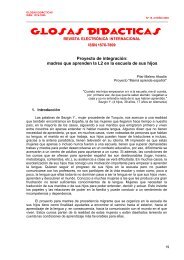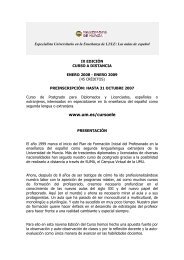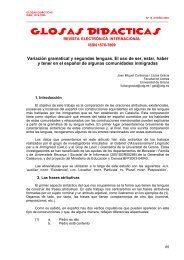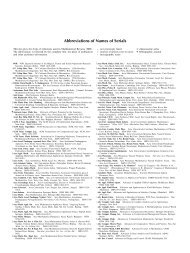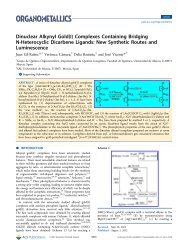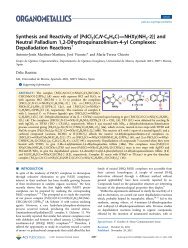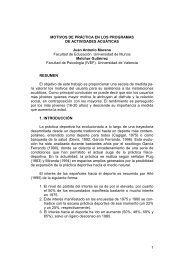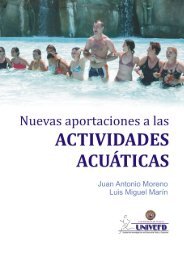New Acetonyl Palladium(II) Complexes - Universidad de Murcia
New Acetonyl Palladium(II) Complexes - Universidad de Murcia
New Acetonyl Palladium(II) Complexes - Universidad de Murcia
You also want an ePaper? Increase the reach of your titles
YUMPU automatically turns print PDFs into web optimized ePapers that Google loves.
3978<br />
Organometallics 2008, 27, 3978–3985<br />
<strong>New</strong> <strong>Acetonyl</strong> <strong>Palladium</strong>(<strong>II</strong>) <strong>Complexes</strong><br />
José Vicente, Aurelia Arcas,* Jesús M. Fernán<strong>de</strong>z-Hernán<strong>de</strong>z, and Delia Bautista ‡<br />
Grupo <strong>de</strong> Química Organometálica, Departamento <strong>de</strong> Química Inorgánica, Facultad <strong>de</strong> Química,<br />
UniVersidad <strong>de</strong> <strong>Murcia</strong>, Apartado 4021, E-30071 <strong>Murcia</strong>, Spain, and SAI, UniVersidad <strong>de</strong> <strong>Murcia</strong>,<br />
Apartado 4021, 30071 <strong>Murcia</strong>, Spain<br />
ReceiVed April 14, 2008<br />
[Pd{CH 2 C(O)Me}Cl] n (1), reacts with P- and N-donor ligands to afford cis-[Pd{CH 2 C(O)Me}Cl(dppf)]<br />
(dppf ) bis(diphenylphosphino)ferrocene (2)) and [Pd{CH 2 C(O)Me}ClL 2 ](L) pyridine ) py (3), 4-Mepyridine<br />
) Mepy (4), 4- t Bu-pyridine ) t Bupy (5)). Reaction of 3 or 3-5 with 1 equiv of [Tl(acac)] or<br />
TlTfO and L affords, respectively, [Pd{CH 2 C(O)Me}(O,O-acac)(py)] (6) or [Pd{CH 2 C(O)Me}L 3 ]TfO<br />
(L ) py (7), Mepy (8), t Bupy (9)). The reaction of 9 with 1 equiv of {Ph 2 P(CH 2 ) 2 } 2 PhP (triphos) gave<br />
[Pd{CH 2 C(O)Me}(triphos)]TfO (10). Complex 1 reacts with norbornene (nbn) followed by addition of<br />
L 2 (1:2:1), with 1,5-cyclooctadiene (cod) (1:1) or with 1,1-dimethyl allene (dma) to give [Pd{(nbn)-<br />
CH 2 C(O)Me}ClL 2 ](L 2 ) 2,2′-bipyridine (bpy) (11), 4,4′-di-tert-butyl 2,2′-bipyridine (dbbpy) (12)),<br />
[Pd{CH 2 C(O)Me}Cl(cod)] (13), or [Pd{η 3 -CH 2 C{CH 2 C(O)Me}Cl] 2 (14), respectively. The structures<br />
of complexes 3, 8, 11, and 13 have been solved by X-ray diffraction studies.<br />
Introduction<br />
We are involved in the synthesis of ketonyl metal complexes 1–7<br />
because some of these species are intermediates in organic<br />
synthesis. 8–10<br />
We have reported the synthesis of the polymer [Pd{CH 2 C-<br />
(O)Me}Cl] n (1), obtained by transmetalation reactions from<br />
[Hg{CH 2 C(O)Me} 2 ] and [PdCl 2 (MeCN) 2 ] or (NMe 4 )[Pd 2 Cl 6 ]. 4<br />
The other methods of synthesis of acetonyl palladium(<strong>II</strong>)<br />
complexes lead to neutral species always containing strongly<br />
coordinated ligands, such as PPh 3 , 11 N,N,N′,N′-tetramethylethylenediamine,<br />
3 C 6 F 5 ,C 6 H 4 CH 2 NMe 2 -2. 12 In contrast with these<br />
complexes, 1 offers the opportunity of preparing neutral acetonyl<br />
complexes simply by bridging splitting reactions with neutral<br />
ligands or cationic acetonyl complexes by replacing the chloro<br />
* To whom correspon<strong>de</strong>nce regarding the synthesis and solution<br />
characterization of complexes should be addressed. E-mail: aurelia@um.es<br />
(A.A.); jvs@um.es (J.V). WWW: http://www.scc.um.es/gi/gqo/.<br />
‡ To whom correspon<strong>de</strong>nce regarding the X-ray diffraction study of<br />
complexes should be sent. E-mail: dbc@um.es.<br />
(1) (a) Vicente, J.; Bermú<strong>de</strong>z, M. D.; Chicote, M. T.; Sánchez-Santano,<br />
M. J. J. Chem. Soc., Chem. Commun. 1989, 141. (b) Vicente, J.; Bermú<strong>de</strong>z,<br />
M. D.; Chicote, M. T.; Sánchez-Santano, M. J. J. Chem. Soc., Dalton Trans.<br />
1990, 1945. (c) Vicente, J.; Bermú<strong>de</strong>z, M. D.; Escribano, J.; Carrillo, M. P.;<br />
Jones, P. G. J. Chem. Soc., Dalton Trans. 1990, 3083. (d) Vicente, J.; Arcas,<br />
A.; Fernán<strong>de</strong>z-Hernán<strong>de</strong>z, J. M.; Sironi, A.; Masciocchi, N. Chem. Commun.<br />
2005, 1267.<br />
(2) (a) Vicente, J.; Abad, J. A.; Cara, G.; Jones, P. G. Angew. Chem.,<br />
Int. Ed. Engl. 1990, 29, 1125. (b) Vicente, J.; Bermú<strong>de</strong>z, M. D.; Carrillo,<br />
M. P.; Jones, P. G. J. Chem. Soc., Dalton Trans. 1992, 1975. (c) Vicente,<br />
J.; Arcas, A.; Fernán<strong>de</strong>z-Hernán<strong>de</strong>z, J. M.; Bautista, D. Organometallics<br />
2006, 25, 4404.<br />
(3) Vicente, J.; Abad, J. A.; Chicote, M. T.; Abrisqueta, M.-D.; Lorca,<br />
J.-A.; Ramírez <strong>de</strong> Arellano, M. C. Organometallics 1998, 17, 1564.<br />
(4) Vicente, J.; Arcas, A.; Fernán<strong>de</strong>z-Hernán<strong>de</strong>z, J. M.; Bautista, D.<br />
Organometallics 2001, 20, 2767.<br />
(5) Vicente, J.; Arcas, A.; Fernán<strong>de</strong>z-Hernán<strong>de</strong>z, J. M.; Bautista, D.;<br />
Jones, P. G. Organometallics 2005, 24, 2516.<br />
(6) (a) Vicente, J.; Abad, J. A.; Cara, G.; Gutierrez-Jugo, J. F. J. Chem.<br />
Soc., Dalton Trans. 1992, 2481. (b) Vicente, J.; Bermú<strong>de</strong>z, M. D.; Carrión,<br />
F. J. Inorg. Chim. Acta 1994, 220, 1. (c) Vicente, J.; Abad, J. A.; Bergs,<br />
R.; Jones, P. G.; Bautista, D. J. Chem. Soc., Dalton Trans. 1995, 3093. (d)<br />
Vicente, J.; Chicote, M. T.; Huertas, S.; Ramírez <strong>de</strong> Arellano, M. C.; Jones,<br />
P. G. Eur. J. Inorg. Chem. 1998, 511. (e) Vicente, J.; Chicote, M. T.; Rubio,<br />
C.; Ramírez <strong>de</strong> Arellano, M. C.; Jones, P. G. Organometallics 1999, 18,<br />
2750.<br />
ligand, which leaves available for substitution three coordination<br />
positions at palladium. We have used 1 to prepare neutral monoand<br />
dinuclear complexes as well as C-palladated β-ketoenamine<br />
complexes resulting from insertion of one molecule of isocyani<strong>de</strong><br />
into the Pd-acetonyl bond. 4,5<br />
We <strong>de</strong>scribe our last report on the synthetic use of 1, showing<br />
the preparation of new types of neutral and the first cationic<br />
acetonyl complexes resulting from its reaction with a variety<br />
of ligands (neutral and anionic, mono<strong>de</strong>ntate N donor, di- and<br />
tri<strong>de</strong>ntate P donor). The insertion of alkenes into Pd-C bonds<br />
has attracted interest, since it constitutes a key step in many<br />
important processes such as the Heck reaction, 9,13 the palladiumcatalyzed<br />
polimerization of olefins, 14,15 and the copolymerization<br />
(7) Vicente, J.; Bermú<strong>de</strong>z, M. D.; Carrillo, M. P.; Jones, P. G. J.<br />
Organomet. Chem. 1993, 456, 305.<br />
(8) (a) Culkin, D. A.; Hartwig, J. F. Acc. Chem. Res. 2003, 36, 234. (b)<br />
So<strong>de</strong>oka, M.; Hamashima, Y. Bull. Chem. Soc. Jpn. 2005, 78, 941. (c) Chen,<br />
G. S.; Kwong, F. Y.; Chan, H. O.; Yu, W. Y.; Chan, A. S. C. Chem.<br />
Commun. 2006, 1413. (d) Ogoshi, S.; Morimoto, T.; Nishio, K.; Ohe, K.;<br />
Murai, S. J. Org. Chem. 1993, 58, 9. (e) Carfagna, C.; Musco, A.; Sallese,<br />
G.; Santi, R.; Fiorani, T. J. Org. Chem. 1991, 56, 261. (f) Palucki, M.;<br />
Buchwald, S. L. J. Am. Chem. Soc. 1997, 119, 11108. (g) Satoh, T.;<br />
Kawamura, Y.; Miura, M.; Nomura, M. Angew. Chem., Int. Ed. Engl. 1997,<br />
36, 1740.<br />
(9) Tsuji, J. <strong>Palladium</strong> Reagents and Catalysts; John Wiley: Chinchester,<br />
U.K., 1995.<br />
(10) Ito, Y.; Hirao, T.; Saegusa, T. J. Org. Chem. 1978, 43, 1011.<br />
(11) (a) Albeniz, A. C.; Catalina, N. M.; Espinet, P.; Redon, R.<br />
Organometallics 1999, 18, 5571. (b) Suzuki, K.; Yamamoto, H. Inorg. Chim.<br />
Acta 1993, 208, 225. (c) Bertani, R.; Castellani, C. B.; Crociani, B. J.<br />
Organomet. Chem. 1984, 269, C15.<br />
(12) Ruiz, J.; Rodríguez, V.; Cutillas, N.; Pardo, M.; Pérez, J.; López,<br />
G.; Chaloner, P.; Hitchcock, P. B. Organometallics 2001, 20, 1973.<br />
(13) (a) Heck, R. F. <strong>Palladium</strong> Reagents in Organic Syntheses; Aca<strong>de</strong>mic<br />
Press: London, U.K., 1985. (b) Beletskaya, I. P.; Cheprakov, A. V. Chem.<br />
ReV. 2000, 100, 3009. (c) Dounay, A. B.; Overman, L. E. Chem. ReV. 2003,<br />
103, 2945.<br />
(14) (a) Johnson, L. K.; Killian, C. M.; Brookhart, M. J. Am. Chem.<br />
Soc. 1995, 117, 6414. (b) Yamamoto, A. J. Chem. Soc., Dalton Trans. 1999,<br />
1027. (c) Ittel, S. D.; Johnson, L. K.; Brookhart, M. Chem. ReV. 2000, 100,<br />
1169.<br />
(15) Mecking, S.; Johnson, L. K.; Wang, L.; Brookhart, M. J. Am. Chem.<br />
Soc. 1998, 120, 888.<br />
10.1021/om8003288 CCC: $40.75 © 2008 American Chemical Society<br />
Publication on Web 06/27/2008
<strong>New</strong> <strong>Acetonyl</strong> <strong>Palladium</strong>(<strong>II</strong>) <strong>Complexes</strong> Organometallics, Vol. 27, No. 15, 2008 3979<br />
of alkenes and CO. 15,16 However, only a few examples of alkene<br />
insertion into the Pd-ketonyl bond have been reported. 10,17 We<br />
<strong>de</strong>scribe here a complex resulting from insertion of an alkene<br />
(norbornene) into the Pd-acetonyl bond and its crystal structure,<br />
which is the first example of a fully characterized palladium<br />
complex of this type.<br />
Allenes have found increasing applications in transition metalcatalyzed<br />
reactions for organic and polymer synthesis. 18 Organopalladium<br />
complexes react with allenes to afford π-allyl<br />
complexes. 19–21 We also report the first example of a reaction<br />
affording a π-allyl complex resulting after insertion of an allene<br />
into a Pd-ketonyl bond.<br />
Experimental Section<br />
Unless otherwise stated, the reactions were carried out without<br />
precautions to exclu<strong>de</strong> light or atmospheric oxygen or moisture.<br />
Melting points were <strong>de</strong>termined on a Reicher apparatus and are<br />
uncorrected. Elemental analyses were carried out with a Carlo Erba<br />
1106 microanalyzer. Molar conductivities were measured on a ca.<br />
5 × 10 -4 M acetone solution with a Crison Micro CM2200<br />
conductimeter. IR spectra were recor<strong>de</strong>d on a Perkin-Elmer 16F<br />
PC FT-IR spectrometer with Nujol mulls between polyethylene<br />
sheets. NMR spectra were recor<strong>de</strong>d in a Brucker AC 200 or Avance<br />
300 or 400 spectrometers at room temperature. Chemical shifts were<br />
referred to TMS ( 1 H, 13 C), H 3 PO 4 ( 31 P), or CFCl 3 ( 19 F). When<br />
nee<strong>de</strong>d, NMR assignments were performed with the help of APT,<br />
DEPT, COSY, one-dimensional NOE experiments, and HETCOR<br />
techniques. Complex 1 was prepared as reported previously. 4<br />
Synthesis of [Pd{CH 2 C(O)Me}Cl(dppf)] (2). To a suspension<br />
of 1 (100 mg, 0.50 mmol) in dry THF (2 mL) was ad<strong>de</strong>d<br />
bis(diphenylphosphino)ferrocene (dppf) (279 mg, 0.50 mmol) un<strong>de</strong>r<br />
N 2 . The mixture was stirred for 15 min, the solution was<br />
concentrated to dryness, and Et 2 O (20 mL) was ad<strong>de</strong>d. The resulting<br />
suspension was filtered and the solid washed with Et 2 O (10 mL)<br />
to give 2 as an orange solid. Yield: 337 mg, 90%. Mp: 140 °C. IR<br />
(Nujol, cm -1 ): ν(CdO) 1640; ν(Pd-Cl) 294. 1 H NMR (200 MHz,<br />
CDCl 3 ): δ 7.97-7.88 (m, 4H, Ph), 7.69-7.59 (m, 4H, Ph),<br />
7.46-7.37 (m, 8H, Ph), 7.29-7.20 (m, 4H, Ph), 4.73 (m, 2H, Cp),<br />
4.52 (m, 2H, Cp), 4.13 (m, 2H, Cp), 3.33 (m, 2H, Cp), 2.70 (dd,<br />
2H, CH 2 , 2 J HPcis ) 5.2 Hz, 2 J HPtrans ) 12.6 Hz), 2.27 (s, 3H, Me).<br />
31 P{ 1 H} NMR (80.95 MHz, CDCl 3 ): δ 38.42 (J PP ) 29 Hz), 17.2<br />
(16) (a) Sen, A. Acc. Chem. Res. 1993, 26, 303. (b) Bianchini, C.; Meli,<br />
A. Coord. Chem. ReV. 2002, 225, 35.<br />
(17) (a) Ito, Y.; Aoyama, H.; Hirao, T.; Mochizuki, A.; Saegusa, T.<br />
J. Am. Chem. Soc. 1979, 101, 494. (b) Ito, Y.; Aoyama, H.; Saegusa, T.<br />
J. Am. Chem. Soc. 1980, 102, 4519.<br />
(18) (a) Zimmer, R.; Dinesh, C. U.; Nandanan, E.; Khan, F. A. Chem.<br />
ReV. 2000, 100, 3067. (b) Hong, S.; Marks, T. J. Acc. Chem. Res. 2004,<br />
37, 673. (c) Ma, S. M. Chem. ReV. 2005, 105, 2829.<br />
(19) (a) Ankersmit, H. A.; Loken, B. H.; Kooijman, H.; Spek, A. L.;<br />
Vrieze, K.; van Koten, G. Inorg. Chim. Acta 1996, 252, 141. (b) Delis,<br />
J. G. P.; Groen, J. H.; Vrieze, K.; van Leeuwen, P.; Veldman, N.; Spek,<br />
A. L. Organometallics 1997, 16, 551. (c) Yagyu, T.; Suzaki, Y.; Osakada,<br />
K. Organometallics 2002, 21, 2088. (d) Canovese, L.; Visentin, F.; Chessa,<br />
G.; Santo, C.; Uguagliati, P.; Bandoli, G. J. Organomet. Chem. 2002, 650,<br />
43. (e) Canovese, L.; Chessa, G.; Santo, C.; Visentin, F.; Uguagliati, P.<br />
Inorg. Chim. Acta 2003, 346, 158. (f) Canovese, L.; Visentin, F.; Chessa,<br />
G.; Uguagliati, P.; Santo, C.; Bandoli, G.; Maini, L. Organometallics 2003,<br />
22, 3230. (g) Sirlin, C.; Chengebroyen, J.; Konrath, R.; Ebeling, G.; Raad,<br />
I.; Dupont, J.; Paschaki, M.; KotzybaHibert, F.; HarfMonteil, C.; Pfeffer,<br />
M. Eur. J. Org. Chem. 2004, 1724.<br />
(20) (a) Ankersmit, H. A.; Veldman, N.; Spek, A. L.; Eriksen, K.;<br />
Goubitz, K.; Vrieze, K.; van Koten, G. Inorg. Chim. Acta 1996, 252, 203.<br />
(b) Canovese, L.; Visentin, F.; Chessa, G.; Uguagliati, P.; Bandoli, G.<br />
Organometallics 2000, 19, 1461.<br />
(21) (a) Vicente, J.; Abad, J.-A.; Bergs, R.; Ramirez <strong>de</strong> Arellano, M. C.;<br />
Martinez-Viviente, E.; Jones, P. G. Organometallics 2000, 19, 5597. (b)<br />
Yagyu, T.; Hamada, M.; Osakada, K.; Yamamoto, T. Organometallics 2001,<br />
20, 1087. (c) Chengebroyen, J.; Linke, M.; Robitzer, M.; Sirlin, C.; Pfeffer,<br />
M. J. Organomet. Chem. 2003, 687, 313.<br />
(d, 2 J PP ) 29 Hz). Anal. Calcd for C 37 H 33 ClFeNOP 2 Pd: C, 58.99;<br />
H, 4.42. Found: C, 58.63; H, 4.53.<br />
Synthesis of [Pd{CH 2 C(O)Me}Cl(py) 2 ] (3). To a suspension<br />
of 1 (195 mg, 0.98 mmol) in acetone (40 mL) was ad<strong>de</strong>d pyridine<br />
(171 µL, 2.11 mmol). The suspension was stirred until 1 dissolved<br />
and then was filtered through Celite. The filtrate was concentrated<br />
(ca. 2 mL), and addition of Et 2 O (20 mL) gave a suspension that<br />
was filtered off. The solid was washed with Et 2 O(2× 5 mL) and<br />
air-dried to give 3 as a yellow solid. Yield: 322 mg, 92%. Mp:<br />
114-116 °C. IR (Nujol, cm -1 ): ν(CdO) 1636 (s); ν(Pd-Cl) 280<br />
(m). 1 H NMR (200 MHz, CDCl 3 , trans:cis isomers 10:1): trans<br />
isomer δ 8.86 (m, 4H, o-H), 7.80 (m, 2H, p-H), 7.40 (m, 4H, m-H),<br />
2.64 (s, 2H, CH 2 ), 1.72 (s, 3H, Me); cis isomer δ 8.73 (m, 2 H,<br />
o-H, py cis to acetonyl), 8.41 (m, 2 H, o-H, py trans to acetonyl),<br />
7.80 (m, 1 H, p-H, py trans to acetonyl), 7.70 (m, 2 H, p-H, py cis<br />
to acetonyl), 7.40 (m, 2 H, m-H, py cis to acetonyl), 7.25 (m, 2 H,<br />
m-H, py trans to acetonyl), 2.81 (s, 2H, CH 2 ), 2.37 (s, 3H, Me).<br />
13 C{ 1 H} NMR (50.32 MHz, CDCl 3 ): trans isomer δ 209.3 (CO),<br />
152.7 (o-C), 138.0 p-C), 125.2 (m-C), 32.1 (CH 2 ), 30.0 (Me); cis<br />
isomer δ 153.2 (py), 152.2 (py), 138.5 (py), 125.7 (py), 124.8 (py),<br />
30.8 (Me), 22.9 (CH 2 ). Anal. Calcd for C 13 H 15 ClN 2 OPd: C, 43.72;<br />
H, 4.23; N, 7.84. Found: C, 43.45; H, 4.21; N, 7.82. Single crystals<br />
of 3 were obtained by slow diffusion of Et 2 O into a solution of 3<br />
in CHCl 3 .<br />
Synthesis of [Pd{CH 2 C(O)Me}Cl(Mepy) 2 ] (4). This yellow<br />
complex was prepared as <strong>de</strong>scribed for 3, using 1 (100 mg, 0.50<br />
mmol) in CH 2 Cl 2 (10 mL) and 4-methyl pyridine (Mepy, 104 µL,<br />
1.06 mmol). Yield: 174 mg, 90%. Dec pt: 126-128 °C. IR (Nujol,<br />
cm -1 ): ν(CdO) 1638 (s); ν(Pd-Cl) 270 (m). 1 H NMR (300 MHz,<br />
CDCl 3 , trans:cis isomers 10:1): trans isomer δ 8.64-8.66 (m, 4H,<br />
o-H), 7.18-7.2 (m, 4H, m-H), 2.61 (s, 2H, CH 2 ), 2.40 (s, 6H,<br />
Mepy), 1.74 (s, 3H, MeCO); cis isomer δ 8.52 (m, 2H, o-H), 8.26<br />
(m, 2H, o-H), 2.75 (s, 2H, CH 2 ). 13 C{ 1 H} NMR (75.43 MHz,<br />
CDCl 3 ): trans isomer δ 209.3 (CO), 152.0 (CH), 150.0 (C), 126.1<br />
(CH), 32.0 (CH 2 ), 30.1 (MeCO), 21.0 (Mepy); cis isomer δ 152.4<br />
(o-C), 151.4 (o-C), 126.5 (m-C), 30.8 (MeCO), 23.0 (CH 2 ), 21.0<br />
(Mepy). Anal. Calcd for C 15 H 19 ClN 2 OPd: C, 46.77; H, 4.97; N,<br />
7.27. Found: C, 46.40; H, 4.88; N, 7.14.<br />
Synthesis of [Pd{CH 2 C(O)Me}Cl( t Bupy) 2 ] (5). This complex<br />
was prepared as <strong>de</strong>scribed for 3, using 1 (150 mg, 0.75 mmol) in<br />
CH 2 Cl 2 (10 mL) and 4-tert-butylpyridine ( t Bupy, 234 µL, 1.58<br />
mmol). The final solution was concentrated (ca. 2 mL) and cooled<br />
in a water/ice bath. Addition of n-pentane (15 mL) and vigorous<br />
stirring gave a suspension that was filtered off, and the solid was<br />
washed with n-pentane (2 × 5 mL) and air-dried to give 5 as a<br />
light-yellow solid. Yield: 324 mg, 91.5%. Dec pt: 128 °C. IR (Nujol,<br />
cm -1 ): ν(CdO) 1638 (s); ν(Pd-Cl) 278 (m). 1 H NMR (300 MHz,<br />
CDCl 3 trans:cis isomers 12:1): trans isomer δ 8.72-8.70 (m, 4H),<br />
7.34-7.36 (m, 4H), 2.64 (s, 2H, CH 2 ), 1.73 (s, 3H, MeCO), 1.31<br />
(s, 18H, t Bu); cis isomer δ 8.59 (m, 2H, o-H), 8.29 (m, 2H, o-H),<br />
7.23 (m, 2H), 2.78 (s, 2H, CH 2 ), 2.37 (s, 3H, MeCO). 13 C{ 1 H}<br />
NMR (75.43 MHz, CDCl 3 ): trans isomer δ 209.3 (CO), 162.3 (Cp),<br />
151.8 (o-C), 122.2 (m-C), 35.0 (CMe 3 ), 31.8 (CH 2 ), 30.0 (CMe 3 ),<br />
30.0 (MeCO); cis isomer δ 152.5 (o-C), 151.5 (o-C), 122.8 (m-C),<br />
121.8 (m-C), 30.9 (MeCO), 22.9 (CH 2 ). Anal. Calcd for<br />
C 21 H 31 ClN 2 OPd: C, 53.74; H, 6.66; N, 5.97. Found: C, 53.35; H,<br />
6.69; N, 5.86.<br />
Synthesis of [Pd{CH 2 C(O)Me}(acac)(py)] (6). To a solution<br />
of 3 (90 mg, 0.25 mmol) in acetone (25 mL) was ad<strong>de</strong>d Tl(acac)<br />
(77 mg, 0.25 mmol). The resulting suspension was stirred for 15<br />
min and filtered through Celite. The filtrate was concentrated to<br />
dryness, and n-hexane (5 mL) was slowly ad<strong>de</strong>d to give an oil that<br />
was stirred in an acetone/ice bath to give a solid, which was filtered<br />
off, washed with n-hexane (5 mL), and air-dried to give 6 as a<br />
yellow solid. Yield: 40 mg, 46%. Mp: 67-68 °C. IR (cm -1 ):<br />
ν(CdO) 1650; ν(CdO, acac) 1582, 1516. 1 H RMN (200 MHz,<br />
CDCl 3 ): δ 8.79-8.83 (m, 2H, py), 7.73-7.82 (m, 1H, py),
3980 Organometallics, Vol. 27, No. 15, 2008 Vicente et al.<br />
7.33-7.40 (m, 2H, py), 5.35 (s, 1H, acac), 2.64 (s, 2H, CH 2 ), 2.20<br />
(s, 3H, MeCOCH 2 ), 2.00 (s, 3H, Me, acac), 1.93 (s, 3H, Me, acac).<br />
13 C{ 1 H} NMR (100.8 MHz, CDCl 3 ): δ 212.6 (MeCOCH 2 ), 187.6<br />
and 185.4 (CO, acac), 152.4 (o-C), 137.5 (Cp), 125.0 (m-C), 99.9<br />
(CH, acac), 30.2 (MeCOCH 2 ), 27.7 (Me, acac), 27.1 (Me, acac),<br />
26.5 (CH 2 ). Anal. Calcd for C 13 H 17 NO 3 Pd: C, 45.70; H, 5.01; N,<br />
4.10. Found: C, 45.40; H, 5.02; N, 4.07.<br />
Synthesis of [Pd{CH 2 C(O)Me}(py) 3 ]TfO (7). TlOTf (103 mg,<br />
0.29 mmol) was ad<strong>de</strong>d to a solution of 3 (100 mg, 0.28 mmol) in<br />
acetone (20 mL). Pyridine (25 µL, 0.3 mmol) was ad<strong>de</strong>d to the<br />
resulting suspension, which was stirred for 15 min and concentrated<br />
to dryness, and CH 2 Cl 2 was ad<strong>de</strong>d (20 mL). The resulting<br />
suspension was stirred for 20 min and filtered through Celite. The<br />
filtrate was concentrated (ca. 3 mL) and Et 2 O was slowly ad<strong>de</strong>d.<br />
The mixture, containing an oil, was stirred for 1hat0°C to give<br />
a suspension, which was filtered off. The solid was washed with<br />
Et 2 O(2× 5 mL), recrystalized from CH 2 Cl 2 /Et 2 O, and air-dried<br />
to give 7 as a yellow solid. Yield: 125 mg, 81%. Mp: 102-104<br />
°C. Λ M (acetone, 4.7 × 10 -4 M): 149 Ω -1 cm 2 mol -1 . IR (Nujol,<br />
cm -1 ): ν(CdO) 1650 (s).<br />
1 H NMR (300 MHz, CDCl 3 ): δ<br />
8.98-8.97 (m, 4H, py cis to acetonyl), 8.67-8.65 (m, 2H, py trans<br />
to acetonyl), 7.86-7.81 (m, 2H, py cis to acetonyl), 7.74-7.69<br />
(m, 1H, py trans to acetonyl), 7.48-7.43 (m, 4H, py cis to acetonyl),<br />
7.36-7.32 (m, 2H, py trans to acetonyl), 2.60 (s, 2H, CH 2 ), 1.78<br />
(s, 3H, Me). 13 C{ 1 H} NMR (75.43 MHz, CDCl 3 ): δ 211.6 (CO),<br />
152.3 (C py cis to acetonyl), 149.8 (C py trans to acetonyl), 138.7<br />
(C py cis to acetonyl), 138.5 (C py trans to acetonyl), 126.2 (C py<br />
cis to acetonyl), 125.9 (C py trans to acetonyl), 30.6 (Me),<br />
28.1(CH 2 ). Anal. Calcd for C 19 H 20 ClF 3 N 3 O 4 PdS: C, 41.50; H, 3.67;<br />
N, 7.64; S, 5.83. Found: C, 41.30; H, 3.40; N, 7.60; S, 5.63.<br />
Synthesis of [Pd{CH 2 C(O)Me}(Mepy) 3 ]TfO · H 2 O (8). To a<br />
suspension of 1 (150 mg, 0.75 mmol) in acetone (7 mL) were ad<strong>de</strong>d<br />
Mepy (240 µL, 2.46 mmol) and TlTfO (271 mg, 0.77 mmol). The<br />
resulting suspension was stirred for 30 min and then was filtered<br />
through Celite. The filtrate was concentrated to dryness, extracted<br />
with CH 2 Cl 2 (20 mL), and filtered through Celite. The filtrate was<br />
concentrated (ca. 1 mL) and Et 2 O (5 mL) was ad<strong>de</strong>d. The mixture,<br />
containing an oil, was stirred in an acetone/ice bath to give a<br />
suspension, which was filtered off to give 8 as a colorless solid.<br />
Yield: 373 mg, 81%. Mp: 94 °C. Λ M (acetone, 4.72 × 10 -4 ): 120<br />
Ω -1 cm 2 mol -1 .IR(cm -1 ): ν(CdO) 1650; ν(OH) 3426. 1 H NMR<br />
(300 MHz, CDCl 3 ): δ 8.74-8.72 (m, 4H, py cis to R), 8.39-8.37<br />
(m, 2H, py trans to R), 7.27-7.24 (m, 4H, py cis to R), 7.14-7.12<br />
(m, 2H, py trans to R), 2.54 (s, 2H, CH 2 ), 2.39 (s, 6H, Mepy cis to<br />
R), 2.27 (s, 3H, Mepy trans to R), 1.76 (s, 3H, MeCO). 13 C{ 1 H}<br />
NMR (75.43 MHz, CDCl 3 ): δ 212.2 (CO), 151.5 (CH py cis to R),<br />
151.13 (C py cis to R), 150.70 (C py trans to R), 149.2 (CH py<br />
trans to R), 127.1 (CH py cis to R), 126.8 (CH py trans to R), 30.7<br />
(MeCO), 27.8 (CH 2 ), 21.1 (Mepy cis to R), 21.0 (Mepy trans to<br />
R). 19 F NMR (282.20 MHz, CDCl 3 ): δ -78.14. Anal. Calcd for<br />
C 22 H 28 F 3 N 3 O 5 PdS: C, 43.32; H, 4.63; N, 6.89; S, 5.26. Found: C,<br />
43.34; H, 4.55; N, 6.99; S, 5.02. Single crystals of 8 · H 2 O were<br />
obtained by slow diffusion of Et 2 O into a solution of 8 in acetone.<br />
Synthesis of [Pd{CH 2 C(O)Me}( t Bupy) 3 ]TfO (9). To a suspension<br />
of 1 (88 mg, 0.44 mmol) in acetone (3 mL) was ad<strong>de</strong>d t Bupy<br />
(0.2 mL, 1.35 mmol). Addition of KTfO (88 mg, 0.46 mmol) gave<br />
a suspension, which was concentrated to dryness, extracted with<br />
CH 2 Cl 2 (5 mL), and filtered through Celite. The filtrate was<br />
concentrated to dryness and n-pentane (10 mL) was ad<strong>de</strong>d. The<br />
mixture, containing an oil, was stirred in an acetone/ice bath to<br />
give a suspension, which was filtered off, washed with n-pentane<br />
(5 mL), and air-dried to give 9 as a colorless solid. Yield: 240 mg,<br />
76%. Mp: 119 °C. Λ M (acetone, 4.8 × 10 -4 ): 109 Ω -1 cm 2 mol -1 .<br />
IR (cm -1 ): ν(CdO) 1644.<br />
1 H NMR (300 MHz, CDCl 3 ): δ<br />
8.83-8.81 (m, 4H, py cis to R), 8.47-8.50 (m, 2H, py trans to R),<br />
7.43-7.41 (m, 4H, py cis to R), 7.31-7.28 (m, 2H, py trans to R),<br />
2.53 (s, 2H, CH 2 ), 1.72 (s, 3 H, Me), 1.29 (s, 18 H, t Bu), 1.21 (s,<br />
9H, t Bu). 13 C{ 1 H} NMR (50.30 MHz, CDCl 3 ): δ 212.6 (CO), 163.5<br />
(C py cis to R), 162.9 (C py trans to R), 151.70 (CH py cis to R),<br />
149.4 (CH py trans to R), 123.3 (CH py cis to R), 122.9 (CH py<br />
trans to R), 35.1 (CMe 3 , cis to R), 35.0 (CMe 3 , trans to R), 30.6<br />
(MeCO), 30.1 (CMe 3 ), 27.8 (CH 2 ). 19 F NMR (282.20 MHz, CDCl 3 ):<br />
δ -78.14. Anal. Calcd for C 31 H 44 F 3 N 3 O 4 PdS: C, 51.84; H, 6.18;<br />
N, 5.85; S, 4.46. Found: C, 51.42; H, 6.19; N, 6.10; S, 4.07.<br />
Synthesis of [Pd{CH 2 C(O)Me}(triphos)]TfO · 0.5THF (10). To<br />
a solution 9 (81.7 mg, 0.11 mmol) in dry THF (4 mL) was ad<strong>de</strong>d<br />
{Ph 2 P(CH 2 ) 2 } 2 PhP (triphos, 61 mg, 0.11 mmol) un<strong>de</strong>r N 2 . After<br />
15 min the solution was concentrated and Et 2 O (2 mL) was ad<strong>de</strong>d.<br />
The resulting suspension was filtered off, and the solid was washed<br />
with Et 2 O (5 mL) and air-dried to give 10 as a colorless solid.<br />
Yield: 77 mg, 74%. Mp: 182-184 °C. Λ M (acetone, 5 × 10 -4 ):<br />
158 Ω -1 cm 2 mol -1 .IR(cm -1 ): ν(CdO) 1628. 1 H NMR (300<br />
MHz, CDCl 3 ): δ 7.71-7.38 (m, 25H, Ph), 3.74 (m, 2H, CH 2 , THF),<br />
3.38-3.33 (m, 2H, CH 2 , triphos), 3.23-3.18 (m, 2H, CH 2 , triphos),<br />
3.10-2.78 (m, 2H, CH 2 , triphos), 2.50-2.38 (m, 2H, CH 2 , triphos),<br />
2.51 (dt, 2H, CH 2 C(O), 3 J HPcis ) 5.1 Hz, 3 J HPtrans ) 10.2 Hz), 1.85<br />
(m, 2H, CH 2, THF). 1.21 (s, 3H, Me). 31 P{ 1 H} (121.42 MHz,<br />
CDCl 3 ): δ 110.1 (t, P trans to R, 2 J PP ) 19.6 Hz), 48.3 (d, P cis to<br />
R, 2 J PP ) 19.6 Hz). 13 C{ 1 H} NMR (75.40 MHz, CDCl 3 ): δ 210.3<br />
(CO), 133.4-131.9 (m, CH, Ph) 129.7-129.3 (m, CH, Ph),<br />
128.6-127.4 (m, C, Ph), 67.9 (THF), 35.0 (dt, CH 2 CO, 2 J CPtrans )<br />
62 Hz, 2 J CPcis ) 3.3 Hz), 30.0 (Me), 26.0 (dt, CH 2 , triphos, 2 J CP )<br />
62 Hz, 2 J CPcis ) 3.3 Hz), 25.5 (THF). 19 F NMR (282.20 MHz,<br />
CDCl 3 ): δ -78.1. Anal. Calcd for C 40 H 42 F 3 O 4.5 PdP 3 S: C, 54.40;<br />
H, 4.79; S, 3.63. Found: C, 54.01; H, 4.73; S, 3.49.<br />
Synthesis of [Pd{C 7 H 10 [CH 2 C(O)Me]}Cl(bpy)] (11). To a<br />
solution of norbornene (110 mg, 1.16 mmol) in dry MeCN (3 mL)<br />
was ad<strong>de</strong>d 1 (116 mg, 0.58 mmol) un<strong>de</strong>r N 2 . The resulting<br />
suspension was stirred for 1 h and filtered un<strong>de</strong>r N 2 . Bpy (91 mg,<br />
0.58 mmol) was ad<strong>de</strong>d to the filtrate to give a suspension, which<br />
was filtered off. The filtrate was concentrated (0.5 mL), Et 2 O (10<br />
mL) was ad<strong>de</strong>d, and the precipitate was filtered off; the solid was<br />
washed with Et 2 O (3 mL) and air-dried to give 11 as a yellow solid.<br />
Yield: 131 mg, 50%. Dec pt: 149 °C. IR (cm -1 ): ν(CdO) 1704;<br />
ν(Pd-Cl) 318. 1 H NMR (400 MHz, CDCl 3 ): δ 9.35 (m, 1H, H6′),<br />
8.80 (m, 1H, H6), 8.40-8.02 (m, 3H, bpy, H3, H3′, H4), 7.95 (m,<br />
1H, H4′), 7.63 (m, 1H, H5), 7.51 (m, 1H, H5′), 3.47 (dd, 1H,<br />
CH 2 C(O), 2 J HH ) 17.3, 3 J HH ) 6.2 Hz), 2.83 (dd, 1H, CH 2 C(O),<br />
2 J HH ) 17.3, 3 J HH ) 7.9 Hz), 2.52 (m, 1H, H12), 2.46 (m, 1H,<br />
H7), 2.22 (m, 2H, H8 and H13), 2.07 (s, 3H, Me), 1.87 (m, 1H,<br />
H9), 1.59 (m, 1H, H10′), 1.31 (m, 2H, H10 and H11), 1.16 (m,<br />
1H, H13′), 1.11 (m, 1H, H11′).<br />
13 C{ 1 H} NMR (100.8 MHz,<br />
CDCl 3 ): δ 210.1 (CO), 155.9 (C, bpy), 152.4 (C, bpy), 149.2 (C6′),<br />
148.9 (C6), 138.4 (C4), 138.3 (C4′), 126.4 (C5), 126.1 (C5′), 122.1<br />
(C3 or C3′), 121.1 (C3 or C3′), 51.5 (C7), 50.9 (CH 2 CO), 46.3<br />
(C12), 46.1 (C8), 42.7 (C9), 36.3 (C13), 31.5 (Me), 31.2 (C11),<br />
29.5 (C10). Anal. Calcd for C 20 H 23 ClN 2 OPd: C, 53.47; H, 5.16;<br />
N, 6.24. Found: C, 53.14; H, 5.15; N, 6.42. Single crystals of 11<br />
were obtained by slow diffusion of Et 2 O into a solution of 11 in<br />
acetone.<br />
Synthesis of [Pd{C 7 H 10 [CH 3 C(O)Me]}Cl(dbbpy)] (12). To a<br />
solution of 1 (127 mg, 0.635 mmol) in dry MeCN (5 mL) was
<strong>New</strong> <strong>Acetonyl</strong> <strong>Palladium</strong>(<strong>II</strong>) <strong>Complexes</strong> Organometallics, Vol. 27, No. 15, 2008 3981<br />
Scheme 1<br />
ad<strong>de</strong>d norbornene (120 mg, 1.27 mmol) un<strong>de</strong>r N 2 . The resulting<br />
suspension was stirred for 1 h and then filtered through Celite. To<br />
the filtrate was ad<strong>de</strong>d dbbpy (170 mg, 0.635 mmol) to give a<br />
suspension, which was concentrated (3 mL) and then filtered off,<br />
washed with n-pentane (5 mL), and air-dried, to give 12 as a yellow<br />
solid. The filtrate was concentrated, Et 2 O was ad<strong>de</strong>d, and the<br />
suspension was filtered to give a second crop of 12. Yield: 170<br />
mg, 47%. IR (cm -1 ): ν(CdO) 1714; ν(Pd-Cl) 326. 1 H NMR (300<br />
MHz, CDCl 3 ): δ 9.21 (m, 1H, dbbpy), 8.69 (m, 1H, dbbpy), 7.96<br />
(m, 1H, dbbpy), 7.90 (m, dbbpy), 7.59 (m, 1H, dbbpy), 7.48 (m,<br />
1H, dbbpy), 3.45 (dd, 1H, CH 2 C(O), 2 J HH ) 17.6, 3 J HH ) 6.3 Hz),<br />
2.89 (dd, 1H, CH 2 C(O), 2 J HH ) 17.6, 3 J HH ) 8.4 Hz), 2.50-2.47<br />
(m, 2H, H7 and H12), 2.24-2.18 (m, 2H, H8 and H13), 2.10 (s,<br />
3H, Me), 1.87 (m, 1H, H9), 1.60-1.53 (m, 1H, H10′), 1.44 (s, 9H,<br />
t Bu), 1.40 (s, 9H, t Bu), 1.35-1.25 (m, 2H, H10 and H11), 1.15<br />
(m, 1H, H13′), 1.11 (m, 1H, H11′). 13 C{ 1 H} NMR (75.45 MHz,<br />
CDCl 3 ): δ 210.4 (CO), 162.8 (C, dbbpy), 156.3 (C, dbbpy), 152.8<br />
(C, dbbpy), 149.1 (C, dbbpy), 148.7 (C, dbbpy), 123.7 (C, dbbpy),<br />
123.4 (C, dbbpy), 118.6 (C, dbbpy), 117.4 (C, dbbpy), 51.1 (CH 2 ),<br />
50.5 (C7), 46.3 (C12), 46.2 (C8), 42.7 (C9), 36.2 (C13), 35.4<br />
(CMe 3 ), 35.3 (CMe 3 ), 31.6 (Me), 31.3 (C11), 30.4 (CMe 3 ), 30.2<br />
(CMe 3 ), 29.7 (C10). Anal. Calcd for C 28 H 39 ClN 2 OPd: C, 59.89; H,<br />
7.00; N, 4.99. Found: C, 58.66; H, 7.61; N, 5.01. See discussion.<br />
Synthesis of [Pd{CH 2 C(O)Me}Cl(cod)] (13). To a suspension<br />
of 1 (150 mg, 0.75 mmol) in dry THF (15 mL) was ad<strong>de</strong>d cod<br />
(104 µL, 0.85 mmol) un<strong>de</strong>r N 2 . When the solid was disolved, the<br />
reaction mixture was filtered un<strong>de</strong>r N 2 and the filtrate was<br />
concentrated (ca. 3 mL). Addition of n-pentane (20 mL) gave a<br />
suspension that was stirred in an acetone/ice bath for 20 min and<br />
filtered un<strong>de</strong>r N 2 . The solid was washed with n-hexane (2 × 5 mL)<br />
and air-dried to give 13 as a yellow solid. Yield: 188 mg, 81%.<br />
Dec pt: 100 °C. IR (cm -1 ): ν(CdO) 1648. 1 H NMR (200 MHz,<br />
C 6 D 6 ): δ 5.71 (2H, CH, cod), 5.10 (2H, CH, cod), 3.00 (2H,<br />
CH 2 CO), 2.53 (3H, Me), 1.40-1.81 (8H, CH 2 , cod). 13 C{ 1 H} NMR<br />
(50.32 MHz, C 6 D 6 ): δ 208.9 (CO), 123.3 (CH, cod), 107.0 (CH,<br />
cod), 35.8 (CH 2 CO), 31.3 (MeCO), 30.8 (CH 2 , cod), 27.4 (CH 2 ,<br />
cod). Anal. Calcd for C 11 H 17 ClOPd: C, 43.02; H, 5.58. Found: C,<br />
43.0; H, 5.52. Single crystals of 13 were obtained by slow diffusion<br />
of Et 2 O into a solution of 13 in CDCl 3 .<br />
Synthesis of [Pd 2 {η 3 -CH 2 C[CH 2 C(O)Me]CMe 2 } 2 (µ-Cl) 2 ] (14).<br />
A solution of 1 (106 mg, 0.54 mmol) in dry MeCN (5 mL) was<br />
stirred with 3-methyl-1,2-butadiene (63.8 µL, 0.64 mmol) un<strong>de</strong>r<br />
N 2 for 1 h and then filtered through Celite and concentrated to<br />
dryness. The residue was stirred with n-pentane (10 mL) and the<br />
resulting suspension was filtered. The solid was washed with<br />
n-pentane (5 mL) and air-dried to give 14 as a pale yellow solid.<br />
Yield: 110 mg, 77%. Dec pt: 180 °C. IR (cm -1 ): ν(CdO) 1714;<br />
ν(Pd-Cl) 260, 240. 1 H NMR (200 MHz, CDCl 3 ): δ 3.78 (H A ,AB<br />
system, 1H, CH 2 C(O), 2 J HH ) 17.4 Hz), 3.61 (d, 1H, CH 2 , allene,<br />
2 J HAHB ) 1.4 Hz), 3.26 (H B , AB system, 1H, CH 2 CO, 2 J HAHB )<br />
17.4 Hz), 3.25 (d, 1H, CH 2 , allene, 2 J HH ) 1.4 Hz), 2.21 (s, 3H,<br />
MeCO), 1.32 (s, 3H, Me, allene), 1.31 (s, 3H, Me, allene). 13 C{ 1 H}<br />
NMR (50.32 MHz, CDCl 3 ): δ 203.9 (CO), 114.9 (C), 91.4 (C),<br />
58.7 CH 2 C(O)), 48.6 (CH 2 , allene), 29.9 (MeCO), 24.3 (Me, allene),<br />
23.4 (Me, allene). Anal. Calcd for C 16 H 26 Cl 2 O 2 Pd 2 : C, 35.95; H,<br />
4.91. Found: C, 35.63; H, 4.90.<br />
X-ray Structure Determinations of <strong>Complexes</strong> 3, 8, 11,<br />
and 13. <strong>Complexes</strong> 3 and 13 were measured on a Siemmens P4<br />
diffractometer. Structure 11 was measured on a Bruker Smart APEX<br />
diffractometer. Data were collected using monochromated Mo KR<br />
radiation in ω scan mo<strong>de</strong>. Structure 8 was measured on a Bruker<br />
Smart 1000 diffractometer in w and f scan mo<strong>de</strong>s. Absorption<br />
corrections were applied on the basis of psi-scans for structures 3<br />
and 13 and multiscans (Program SADABS) for structures 8 and<br />
11. All structures were refined anisotropically on F 2 . The methyl<br />
groups were refined using rigid groups (AFIX 137), water hydrogens<br />
in compound 8 were refined as free with DFIX, and the other<br />
hydrogens were refined using a riding mo<strong>de</strong>l. Special features:<br />
Complex 8: The triflate anion is disor<strong>de</strong>red over three positions<br />
(0.67:0.24:0.09). An unexpected difference peak was tentatively<br />
i<strong>de</strong>ntified as a water molecule. Reasonable hydrogen sites for the<br />
water could be located and refined.<br />
Results and Discussion<br />
Reactions of [Pd{CH 2 C(O)Me}Cl] n (1) with P- and N-<br />
Donor Ligands to Give Neutral <strong>Complexes</strong>. The reaction of<br />
1 with 1 equiv of bis(diphenylphosphino)ferrocene (dppf) in<br />
THF un<strong>de</strong>r N 2 gave cis-[Pd{CH 2 C(O)Me}Cl(dppf)] (2) (Scheme<br />
1) instead of the <strong>de</strong>sired enolato complex that could be formed<br />
due to the strong transphobia between C- and P-donor ligands.<br />
Thus, the reaction of cis-[PdBr(Ar)(dpb)] (dpb ) 1,2-bis(diphenylphosphino)benzene)<br />
with K{OC(dCMe 2 )Ph} gives the enolato<br />
complex cis-[Pd(Ar){OC(dCMe 2 )Ph}(dpb)], although most<br />
potassium enolates afford the corresponding 2-oxoalkyl <strong>de</strong>rivatives.<br />
22<br />
(22) Culkin, D. A.; Hartwig, J. F. Organometallics 2004, 23, 3398.
3982 Organometallics, Vol. 27, No. 15, 2008 Vicente et al.<br />
Addition of pyridine ligands (2.1:1) to suspensions of 1 in<br />
acetone affords complexes [Pd{CH 2 C(O)Me}ClL 2 ](L) py (3),<br />
Mepy (4), t Bupy (5)) with good yields (>90%). <strong>Complexes</strong> 3<br />
and 4 can be easily precipitated from their solutions by addition<br />
of Et 2 O, but isolation of 5 required the use n-pentane as<br />
precipitating agent. We have unsuccessfully attempted to prepare<br />
dinuclear complexes containing bridging acetonyl ligands<br />
such as [Pd 2 {CH 2 C(O)Me}{µ-κ 2 -C,O-CH 2 C(O)Me}(µ-Cl)Cl-<br />
(dmso) 2 ], which we reported previously. 4 Thus, when 1 was<br />
reacted with py, Mepy, or t Bupy in 1:1 molar ratio, complexes<br />
3-5 were obtained along with 50% of unreacted 1. CDCl 3<br />
solutions of complexes 3-5 contain an approximately 10:1<br />
mixture of trans and cis isomers. Complex 3 reacts with Tl(acac)<br />
in 1:1 molar ratio to give [Pd{CH 2 C(O)Me}(acac)(py)] (6).<br />
Although complexes 2-6 are air stable, CDCl 3 solutions of 2-5<br />
slowly <strong>de</strong>compose to give acetone and [PdCl 2 L 2 ].<br />
Synthesis of Cationic <strong>Complexes</strong>. The room-temperature<br />
reaction of complex 3 or 5 with TlOTf (1:1 molar ratio) in dry<br />
acetone gives almost instantly a precipitate of TlCl. From the<br />
filtrate, a mixture (by NMR) of products was isolated that we<br />
could not separate. However, bands corresponding to ν(CO)<br />
appearing at lower frequencies than in the starting complexes<br />
suggest the formation of some complex containing a bridging<br />
acetonyl or η 3 -oxoallyl ligand.<br />
Addition of L to the suspensions resulting from addition of<br />
TlOTf (1:1 molar ratio) in THF or acetone to complexes 3-5<br />
led to the isolation of the corresponding cationic complexes<br />
[Pd{CH 2 C(O)Me}L 3 ]TfO (L ) py (7), Mepy (8), t Bupy (9)).<br />
Alternatively, reaction of 1 with Mepy or t Bupy and QTfO (Q<br />
) Tl, K, respectively) (1:3:1) also affor<strong>de</strong>d complex 8 or 9,<br />
respectively. The reaction of 9 with triphos (1:1 molar ratio) in<br />
THF gave [Pd{CH 2 C(O)Me}(triphos)]TfO (10). We <strong>de</strong>signed<br />
this reaction assuming that the P/C transphobia 23 induced a<br />
change of the acetonyl ligand to the enolato coordination mo<strong>de</strong>.<br />
This has been observed in a few cases. Thus, although<br />
cis-[Pd(Ar)Br(dpb)] (Ar ) C 6 H 4 Me-2, C 6 H 4 t Bu-4; dpb ) 1,2-<br />
bis(diphenylphosphino)benzene) reacts with different potassium<br />
enolates KOC(dCRR′)R′′ to give the expected 2-oxoalkyl<br />
complexes cis-[Pd(Ar){CRR′C(O)R′′}(dpb)], when R ) R′ )<br />
Me and R”′′ ) Ph, the enolato isomer cis-[Pd(Ar){OC(d<br />
CMe 2 )C(O)Ph}(dpb)] was obtained. 22,24 The stabilization of the<br />
enolato isomer was attributed to steric reasons, which explains<br />
that in our case (R ) R′ ) H and R′′ ) Me) the ketonyl isomers<br />
2 and 10 were obtained.<br />
Reactions of 1 with Alkenes and Allenes. The reaction of<br />
1 with norbornene (nbn, 1:2) was followed by 1 H NMR in<br />
CD 3 CN. After 1 h, the reaction mixture showed the absence of<br />
complex 1. When the reaction was repeated in a preparative<br />
scale in MeCN, a solid could be precipitated by addition of<br />
Et 2 O. This solid could not be i<strong>de</strong>ntified, but the presence of a<br />
band at 1714 cm -1 in the IR spectra suggested the insertion of<br />
the alkene into the Pd-C acetonyl bond. However, the reaction of<br />
1 with norbornene followed by addition of bpy or dbbpy (1:2:<br />
Scheme 2<br />
1) led to [Pd{(nbn)CH 2 C(O)Me}ClL 2 ](L 2 ) bpy (11), dbbpy<br />
(12)) (Scheme 2), although 12 could not be obtained analytically<br />
pure. Complex 11 results from the syn insertion of the exo face<br />
of the norbornene double bond into the Pd-C acetonyl bond. This<br />
is the general mo<strong>de</strong> of insertion of this olefin into Pd-C bonds. 25<br />
Only a limited number of examples of alkene insertion into a<br />
Pd-C ketonyl bond have been reported, 17,26 but 11 is the first such<br />
complex fully characterized. The behavior of 1 toward other<br />
olefins (cyclohexene, cyclooctene, maleic anhydri<strong>de</strong>, and dimethyl<br />
maleate) was followed by 1 H NMR in CD 3 CN, but no<br />
reaction was observed in any case after several days.<br />
The reaction between 1 and 1,5-cyclooctadiene (cod; 1:1<br />
molar ratio) in dry THF gave [PdCl{CH 2 C(O)Me}(η 4 -cod)] (13,<br />
Scheme 2). When the reaction was carried out in acetone, 13<br />
was obtained contaminated with an impurity. The 1 H NMR<br />
spectrum in CDCl 3 solution of the cru<strong>de</strong> product showed the<br />
presence of [PdCl 2 (cod)], which could be the product of the<br />
(23) (a) Vicente, J.; Abad, J. A.; Frankland, A. D.; Ramírez <strong>de</strong> Arellano,<br />
M. C. Chem.-Eur. J. 1999, 5, 3066. (b) Vicente, J.; Abad, J. A.; Hernán<strong>de</strong>z-<br />
Mata, F. S.; Jones, P. G. J. Am. Chem. Soc. 2002, 124, 3848. (c) Vicente,<br />
J.; Abad, J. A.; Martínez-Viviente, E.; Jones, P. G. Organometallics 2002,<br />
21, 4454. (d) Vicente, J.; Arcas, A.; Bautista, D.; Jones, P. G. Organometallics<br />
1997, 16, 2127. (e) Vicente, J.; Arcas, A.; Gálvez-López, M. D.;<br />
Jones, P. G. Organometallics 2006, 25, 4247. (f) Jalil, M. A.; Fujinami, S.;<br />
Nishikawa, H. J. Chem. Soc., Dalton Trans. 2001, 1091. (g) Amatore, C.;<br />
Bahsoun, A. A.; Jutand, A.; Meyer, G.; Ntepe, A. N.; Ricard, L. J. Am.<br />
Chem. Soc. 2003, 125, 4212. (h) Crespo, M.; Granell, J.; Solans, X.; Font-<br />
Bardía, M. J. Organomet. Chem. 2003, 681, 143. (i) López, C.; Caubet,<br />
A.; Pérez, S.; Solans, X.; Font-Bardía, M. J. Organomet. Chem. 2003, 681,<br />
82. (j) Marshall, W. J.; Grushin, V. V. Organometallics 2003, 22, 555.<br />
Figure 1. Ellipsoid representation of complex 3 (50% probability).<br />
Selected bond lengths (Å) and angles (<strong>de</strong>g): Pd-N(2) ) 2.0262(17),<br />
Pd-N(1) ) 2.0270(17), Pd-C(1) 2.0804(19), Pd-Cl ) 2.3869(5),<br />
O(1)-C(2) ) 1.232(3), C(1)-C(2) ) 1.460(3), C(2)-C(3) )<br />
1.511(3), N(2)-Pd-C(1) ) 90.03(7), N(1)-Pd-C(1) ) 87.61(7),<br />
N(2)-Pd-Cl ) 91.18(5), N(1)-Pd-Cl ) 91.17(5), N(2)-Pd-N(1)<br />
) 177.61(6).
<strong>New</strong> <strong>Acetonyl</strong> <strong>Palladium</strong>(<strong>II</strong>) <strong>Complexes</strong> Organometallics, Vol. 27, No. 15, 2008 3983<br />
Figure 2. Ellipsoid representation of complex 8 (50% probability).<br />
Selected bond lengths (Å) and angles (<strong>de</strong>g): Pd-N(31) ) 2.0269(18),<br />
Pd-N(21) ) 2.0328(18), Pd-C(1) ) 2.056(2), Pd-N(11) )<br />
2.1202(19), C(1)-C(2) ) 1.464(4), O(1)-C(2) ) 1.229(3),<br />
C(2)-C(3))1.512(3),N(31)-Pd-C(1))89.60(9),N(21)-Pd-C(1)<br />
) 90.56(9), N(31)-Pd-N(11) ) 89.83(7), N(21)-Pd-N(11) )<br />
89.96(7), C(2)-C(1)-Pd ) 108.20(16), O(1)-C(2)-C(1)<br />
) 122.5(2), O(1)-C(2)-C(3) ) 119.1(2), C(1)-C(2)-C(3) )<br />
118.5(2).<br />
Figure 3. Ellipsoid representation of complex 11 (50% probability).<br />
Selected bond lengths (Å) and angles (<strong>de</strong>g): Pd(1)-C(11) )<br />
2.043(2), Pd(1)-N(1) ) 2.0753(17), Pd(1)-N(2) ) 2.1518(18),<br />
Pd(1)-Cl(1) ) 2.3069(12), O(1)-C(17) ) 1.210(3), C(11)-C(12)<br />
) 1.544(3), C(11)-C(15) ) 1.571(2), C(12)-C(13) ) 1.536(3),<br />
C(12)-C(19) ) 1.548(3), C(13)-C(14) ) 1.530(3), C(14)-C(20)<br />
) 1.541(3), C(14)-C(15) ) 1.550(3), C(15)-C(16) ) 1.528(3),<br />
C(16)-C(17) ) 1.510(3), C(17)-C(18) ) 1.509(3), C(19)-C(20)<br />
) 1.554(3), C(11)-Pd(1)-N(1) ) 93.56(7), N(1)-Pd(1)-N(2) )<br />
78.42(6), C(11)-Pd(1)-Cl(1) ) 94.36(6), N(2)-Pd(1)-Cl(1) )<br />
93.51(5), C(12)-C(11)-C(15) ) 103.09(14), C(13)-C(12)-C(11)<br />
) 102.64(15), C(13)-C(12)-C(19) ) 100.61(17), C(11)-C(12)-<br />
C(19))107.15(17),C(14)-C(13)-C(12))94.74(16),C(13)-C(14)-C(20)<br />
)102.22(17),C(13)-C(14)-C(15))101.85(15),C(20)-C(14)-C(15)<br />
) 107.97(16), C(16)-C(15)-C(14) ) 111.82(15), C(16)-C(15)-<br />
C(11))115.50(15),C(14)-C(15)-C(11))102.45(14),C(17)-C(16)-C(15)<br />
)114.15(16),O(1)-C(17)-C(18))120.55(19),O(1)-C(17)-C(16)<br />
) 122.22(18), C(18)-C(17)-C(16) ) 117.22(18), C(12)-C(19)-<br />
C(20) ) 103.54(16), C(14)-C(20)-C(19) ) 102.70(17).<br />
reaction between DCl (from CDCl 3 ) and an hydroxo complex<br />
(the impurity?) resulting from the hydrolysis of 13. In addition,<br />
13 slowly <strong>de</strong>composes in chlorinated solvents to give<br />
[PdCl 2 (cod)]. The reaction of 1 with norbornadiene (1:1 molar<br />
Figure 4. Ellipsoid representation of complex 13 (50% probability).<br />
Selected bond lengths (Å) and angles (<strong>de</strong>g): Pd-C(1) ) 2.072(3),<br />
Pd-C(5) ) 2.178(3), Pd-C(4) ) 2.193(3), Pd-Cl ) 2.3268(9),<br />
Pd-C(9) ) 2.329(3), Pd-C(8) ) 2.358(3), O-C(2) ) 1.225(4),<br />
C(1)-C(2) ) 1.467(5), C(2)-C(3) ) 1.501(5), C(4)-C(5) )<br />
1.380(5), C(4)-C(11) ) 1.520(4), C(5)-C(6) ) 1.512(4), C(6)-C(7)<br />
) 1.525(5), C(7)-C(8) ) 1.504(5), C(8)-C(9) ) 1.354(5),<br />
C(9)-C(10) ) 1.499(4), C(10)-C(11) ) 1.539(5), C(1)-Pd-C(5)<br />
) 89.66(13), C(1)-Pd-C(4)) 92.41(13), C(5)-Pd-C(4) )<br />
36.81(12), C(1)-Pd-Cl ) 89.72(10), C(5)-Pd-C(9) ) 94.95(12),<br />
C(4)-Pd-C(9))81.17(12),Cl-Pd-C(9))92.23(9),C(5)-Pd-C(8)<br />
) 80.17(12), C(4)-Pd-C(8) ) 87.10(12), Cl-Pd-C(8) ) 95.09(9),<br />
C(9)-Pd-C(8) ) 33.58(11).<br />
ratio) in dry THF gave a mixture of products that could not be<br />
separated.<br />
Addition of 1,1-dimethyl allene (dma) to a solution of 1 in<br />
acetonitrile (1.2:1 molar ratio) led to the isolation of the<br />
dinuclear π-allyl complex [Pd{η 3 -CH 2 C[CH 2 C(O)Me]CMe 2 } 2 (µ-<br />
Cl) 2 ](14, Scheme 2), resulting from the insertion of the allene<br />
intothePd-Cbond.ThereactionofMe 4 N[Pt{CH 2 C(O)Me}Cl 2 (η 2 -<br />
C 2 H 4 )] with dma gives instead the substitution product cis-<br />
Me 4 N[Pt{CH 2 C(O)Me}Cl 2 (η 2 -H 2 CdCdCMe 2 )]. 27<br />
Crystals apparently suitable for an X-ray crystallographic<br />
study were obtained for 14, but although the structure shown<br />
in Scheme 2 was established, a complete crystallographic<br />
analysis was not possible. Disor<strong>de</strong>r was so severe that, <strong>de</strong>spite<br />
repeated attempts and data collection at low temperature, no<br />
satisfactory refinement was achieved. However, the composition<br />
and the position of the organic ligand acting as η 3 -allyl were<br />
established with certainty. η 3 -Allyl palladium complexes have<br />
(24) Culkin, D. A.; Hartwig, J. F. J. Am. Chem. Soc. 2001, 123, 5816.<br />
(25) (a) Zocchi, M.; Tieghi, G.; Albinati, A. J. Chem. Soc., Dalton Trans.<br />
1973, 883. (b) Kang, M.; Sen, A. Organometallics 2004, 23, 5396. (c)<br />
Zocchi, M.; Tieghi, G. J. Chem. Soc., Dalton Trans. 1979, 944. (d) Reddy,<br />
K. R.; Surekha, K.; Lee, G.-H.; Peng, S.-M.; Chen, J.-T.; Liu, S.-T.<br />
Organometallics 2001, 20, 1292. (e) Brumbaugh, J. S.; Whittle, R. R.;<br />
Parvez, M.; Sen, A. Organometallics 1990, 9, 1735. (f) Bocelli, G.; Catellani,<br />
M.; Ghelli, S. J. Organomet. Chem. 1993, 458, C12. (g) Tanaka, D.;<br />
Romeril, S. P.; Myers, A. G. J. Am. Chem. Soc. 2005, 127, 10323. (h)<br />
Catellani, M.; Mealli, C.; Motti, E.; Paoli, P.; Perez-Carreño, E.; Pregosin,<br />
P. S. J. Am. Chem. Soc. 2002, 124, 4336. (i) Spek, A. L.; Markies, B. A.;<br />
Kruis, D.; Boersma, J.; van Koten, G. Acta Crystallogr., Sect. C 1995, 51,<br />
1535. (j) Vicente, J.; Abad, J. A.; López-Sáez, M. J.; Förtsch, W.; Jones,<br />
P. G. Organometallics 2004, 23, 4414.<br />
(26) Ito, Y.; Nakatsuka, M.; Kise, N.; Saegusa, T. Tetrahedron Lett.<br />
1980, 21, 2873.<br />
(27) Vicente, J.; Arcas, A.; Fernán<strong>de</strong>z-Hernán<strong>de</strong>z, J. M.; Aullón, G.;<br />
Bautista, D. Organometallics 2007, 26, 6155.
3984 Organometallics, Vol. 27, No. 15, 2008 Vicente et al.<br />
Table 1. Crystallographic Data for <strong>Complexes</strong><br />
3 8 11 13<br />
formula C 13H 15ClN 2OPd C 22H 28F 3N 3O 5Pd S C 20H 23ClN 2OPd C 11H 17ClOPd<br />
fw 357.12 609.93 449.25 307.10<br />
cryst habit lath block block block<br />
cryst size (mm) 0.54 × 0.30 × 0.10 0.40 × 0.20 × 0.20 0.32 × 0.22 × 0.08 0.21 × 0.20 × 0.17<br />
cryst system triclinic monoclinic triclinic orthorhombic<br />
space group P1 P2 1/c P1 Pbca<br />
cell constants<br />
a (Å) 8.2358(6) 14.0831(12) 7.956(5) 8.2836(8)<br />
b (Å) 8.817(2) 11.5607(11) 9.980(5) 13.7315(7)<br />
c (Å) 10.974(2) 16.9448(14) 12.514(5) 19.6036(11)<br />
R (<strong>de</strong>g) 73.534(5) 90 97.255(5) 90<br />
β (<strong>de</strong>g) 87.561(5) 112.467(4) 105.519(5) 90<br />
γ (<strong>de</strong>g) 63.968(5) 90 103.746(5) 90<br />
volume (Å 3 ) 683.6(2) 2549.4(4) 910.6(8) 2229.8(3)<br />
Z 2 4 2 8<br />
λ (Å) 0.71073 0.71073 0.71073 0.71073<br />
F calcd (Mg m -3 ) 1.735 1.589 1.638 1.830<br />
µ(Mo KR) (mm -1 ) 1.541 0.869 1.176 1.868<br />
F(000) 356 1240 456 1232<br />
T (K) 173(2) 133(2) 100(2) 173(2)<br />
2θ max (<strong>de</strong>g) 50 60 52.7 50<br />
no. of reflns measd 2523 39 875 10 018 3827<br />
no. of in<strong>de</strong>p reflns 2354 7461 3691 1962<br />
transmissions 0.8611 and 0.4899 0.862 and 0.700 0.9118 and 0.7047 0.7418 and 0.6950<br />
R int 0.008 0.029 0.0143 0.0307<br />
abs corr psi-scans semiempirical from equivalents semiempirical from equivalents psi-scans<br />
no. restrnts/params 2354/136/164 560/386 0/227 88/128<br />
R w(F 2 , all reflns) 0.0425 0.0910 0.0582 0.0446<br />
R(F, > 4σ(F)) 0.016 0.0320 0.0217 0.0232<br />
S 1.07 1.049 1.13 0.84<br />
max ∆F (e Å -3 ) 0.32 1.11 0.33 0.40<br />
been obtained by reacting alkyl, 20,28 aryl, 21 or acyl 28 palladium<br />
<strong>de</strong>rivatives with allenes.<br />
All attempts to react acetonitrile solutions of 1 with heterocumulenes<br />
(CS 2 and RNdCdS) or alkynes (diphenylacetylene<br />
and dimethyl acetilendicarboxylate) were unsuccessful, and<br />
the starting compounds or complex mixtures of products were<br />
obtained.<br />
Crystal Structures. The crystal structures of complexes 3<br />
(Figure 1), 8 (Figure 2), 11 (Figure 3), and 13 (Figure 4)<br />
have been solved. The palladium atoms are in an almost<br />
square-planar coordination. The <strong>de</strong>creasing trans influence<br />
of the ligands alkyl > acetonyl > olefin > chloro > pyridine<br />
≈ bpy is shown by comparing the metal-to-donor atom bond<br />
distances. Thus, Pd-N bond distances trans to: py or bpy in<br />
3 or 8 (2.0269(2)-2.0328(2) Å) < chloro in 11 (2.0753(17)<br />
Å) < acetonyl in 8 (2.1202(19) Å) < alkyl in 11 (2.1518(18)<br />
Å); Pd-C olefin bond distances in 13 trans to: Cl (2.193(3),<br />
2.178(3) Å) < acetonyl (2.358(3) and 2.329(3) Å); Pd-Cl<br />
bond distances trans to: bpy in 11 (2.3069(12) Å) < olefin<br />
in 13 (2.3268(9) Å) < acetonyl 3 (2.3869(6) Å); and Pd-CH 2<br />
bond distances trans to: t Bupy in 8 (2.056(2) Å) < olefin in<br />
13 (2.072(3) Å) ≈ chloro (2.0804(19) Å).<br />
The structure of 11 shows the exo insertion of norbornene<br />
into the Pd-acetonyl bond. The CdO (1.210(3) Å) or CH 2 -CO<br />
(1.510(3) Å) bond distance in 11 is slightly shorter or longer,<br />
respectively, than in 3 [1.232(3), 1.460(3) Å, respectively], 8<br />
[1.229(3), 1.464(4) Å, respectively], or 13 [1.225(4), 1.467(5)<br />
Å, respectively]. In general, CdO and CH 2 -CO bond distances<br />
inotheracetonylmetalcomplexesareintheranges1.209(3)-1.232(5)<br />
and 1.475(4)-1.516(5), respectively. 2–5,7 The molecules of 11<br />
associate in dimers through a π ···π stacking of the bpy rings<br />
with a centroid-centroid distance of 3.450 Å.<br />
(28) Ruelke, R. E.; Kliphuis, D.; Elsevier, C. J.; Fraanje, J.; Goubitz,<br />
K.; van Leeuwen, P. W. N. M.; Vrieze, K. J. Chem.Soc., Chem. Commun.<br />
1994, 1817.<br />
Spectroscopic Properties. The 1 H NMR spectra of complexes<br />
show the methyl proton resonances in the wi<strong>de</strong> range<br />
1.21-2.53 ppm <strong>de</strong>pending on neighboring group effects. Thus,<br />
in 10, some of the aryl groups of the phosphine ligand cause<br />
the maximum shielding (1.21 ppm); in trans-3-5 and 7-9, the<br />
pyridine ligands lead to an intermediate shielding (1.72-1.78<br />
ppm), while in cis-3, cis-4, 6, and 11-14 the lower shielding<br />
is reached (2.07-2.53 ppm). The methylene acetonyl protons<br />
appear as singlets in the range 2.51-3.00 for complexes 3-9<br />
and 13. Those of complex 2 give a doublet of doublets at 2.70<br />
ppm, and the 31 P{ 1 H} NMR spectrum consists of two doublets,<br />
in agreement with the proposed structure. For CDCl 3 solutions<br />
of complexes 3-5, 1 H and 13 C NMR spectra, HMQC, and<br />
NOESY 2D experiments reveal they are 10-12:1 mixtures of<br />
trans/cis isomers. In the 1 H NMR spectra of complex 10, the<br />
CH 2 C(O) protons appear as a doublet of triplets and the 31 P{ 1 H}<br />
NMR shows a triplet and a doublet for the P atoms trans and<br />
cis to the acetonyl ligand, respectively. The insertion of<br />
norbornene into the Pd-CH 2 bond to give complexes 11 and<br />
12 causes the expected <strong>de</strong>shielding in only one of the methylene<br />
protons (3.45-3.47 ppm), while the other must be shiel<strong>de</strong>d by<br />
one of the bpy rings (2.83-2.89 ppm). In complex 14, both<br />
methylene protons are, as expected, more <strong>de</strong>shiel<strong>de</strong>d (3.78, 3.26<br />
ppm) than those in the acetonyl complexes.<br />
The 1 H NMR spectrum of 11 shows the nonequivalence of<br />
the halves of the bpy ligand. 1 H NOESY 2D experiments reveal<br />
an interchange between both halves. A similar behavior has been<br />
found in other organopalladium complexes. 29,30 It has been<br />
(29) (a) van Asselt, R.; Vrieze, K.; Elsevier, C. J. Organomet. Chem.<br />
1994, 480, 27. (b) Gogoll, A.; Örnebro, J.; Grennberg, H.; Bäckvall, J. E.<br />
J. Am. Chem. Soc. 1994, 116, 3631. (c) Markies, B. A.; Kruis, D.; Rietveld,<br />
M. H. P.; Verkerk, K. A. N.; Boersma, J.; Kooijman, H.; Lakin, M. T.;<br />
Spek, A. L.; van Koten, G. J. Am. Chem. Soc. 1995, 117, 5263.<br />
(30) Delis, J. G. P.; Aubel, P. G.; Vrieze, K.; van Leeuwen, P. W. N. M.;<br />
Veldman, N.; Spek, A. L.; van Neer, F. J. R. Organometallics 1997, 16,<br />
2948.
<strong>New</strong> <strong>Acetonyl</strong> <strong>Palladium</strong>(<strong>II</strong>) <strong>Complexes</strong> Organometallics, Vol. 27, No. 15, 2008 3985<br />
proposed that it is due to a site exchange of the nitrogen donor<br />
atoms. The mechanism of this process involves Pd-N bond<br />
breaking and subsequent isomerization via a Y-shaped intermediate.<br />
30 In 11, the same mechanism could explain its fluxional<br />
behavior, although the intermediate could be a square-planar<br />
complex due to coordination of the carbonyl group. A similar<br />
behavior is found for complex 12. The allyl moiety in 14 shows<br />
the syn and anti protons with a typical geminal coupling for<br />
this compound. NOESY 2D experiments reveal a NOE between<br />
the H anti and the Me anti. One CH 2 C(O) proton has a NOE<br />
with the Me syn, and the other one has a NOE with the H syn.<br />
This could be due to the rotational hindrance of the acetonyl<br />
group around the C-CH 2 C(O) bond.<br />
One absorption is observed in the IR spectra of complexes<br />
2-10 and 13, in the region 1628-1650 cm -1 , corresponding<br />
to ν(CdO) in a terminal acetonyl ligand. 1–5 However, the<br />
absorption assignable to ν(CdO) in complexes 11, 12, and 14<br />
appears where it is observed in organic ketones (1704-1714<br />
cm -1 ). The difference is in agreement with the shortening<br />
observed in the CdO distance in 11 with respect to those in 3<br />
and 8 (see above).<br />
The absorption frequency of the ν(Pd–Cl) band in the IR<br />
spectra of chloro complexes increases as the trans influence of<br />
the ligands <strong>de</strong>creases: acetonyl (3-5; 270-280 cm -1 ) ><br />
P-donor ligand (2; 294 cm -1 ) > N-donor ligand (11, 12; 318<br />
and 326 cm -1 ), which is in accordance with the X-ray crystal<br />
structure data of 3 and 11 (see above). The ν(PdCl) band in 13<br />
could not be assigned because several bands appear in the lowenergy<br />
region. The bands at 240 and 260 cm -1 in 14 can be<br />
assigned to ν(PdCl) mo<strong>de</strong>s corresponding to bridging chloro<br />
ligands.<br />
Conclusion<br />
We report our final illustration of the synthetic capacity of<br />
the polymer [Pd{CH 2 C(O)Me}Cl] n to prepare in good yields<br />
new types of acetonyl complexes: trans-[Pd{CH 2 C(O)Me}ClL 2 ],<br />
[Pd{CH 2 C(O)Me}L 3 ] + , and [Pd{CH 2 C(O)Me}(O,O-acac)L] + .<br />
Reactions with alkenes afford the adduct [Pd{CH 2 C(O)Me}-<br />
Cl(cod)], the product resulting from the syn insertion of the exo<br />
face of the norbornene double bond into the Pd-C acetonyl bond,<br />
[Pd{(nbn)CH 2 C(O)Me}ClL 2 ], which is the first such complex<br />
fully characterized, or the π-allyl complex [Pd{η 3 -CH 2 C-<br />
[CH 2 C(O)Me]CMe 2 } 2 (µ-Cl) 2 ] resulting from the insertion of<br />
1,1-dimethyl allene in the Pd-C acetonyl bond.<br />
Acknowledgment. We thank Ministerio <strong>de</strong> Ciencia y<br />
Tecnología and FEDER for financial support (CTQ2004-<br />
05396) and Prof. Peter G. Jones for provision of data<br />
collection facilities. J.M.F.-H. acknowledges grants from<br />
Fundación Séneca and Fundación Cajamurcia.<br />
Supporting Information Available: CIF files, listing of all<br />
refined and calculated atomic coordinates, anisotropic thermal<br />
parameters, bond length and angles for complexes 3, 8, 11, and<br />
13. This material is available free of charge via the Internet at<br />
http://pubs.acs.org.<br />
OM8003288


